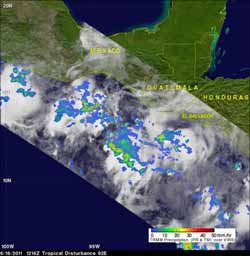System 92E looking more like a developing east Pacific tropical storm

This TRMM satellite image of rainfall within the low pressure area called System 92E shows that most of the rainfall is moderate with some areas of heavy rainfall over the Eastern Pacific Ocean. The yellow and green areas indicate moderate rainfall between 0.78 to 1.57 inches per hour. Red areas are heavy rainfall at almost 2 inches per hour. Credit: Credit: NASA/SSAI, Hal Pierce<br>
On Friday, June 17, 2011, System 92E appeared on satellite imagery as a broad area of low pressure that contained showers and thunderstorms. System 92E was located several hundred miles south of the Gulf of Tehuantepec. The gulf is a large area at 16 North and 95 West, which is right where the low pressure area is centered. Many tropical cyclones in the Eastern Pacific get organized near or in the Gulf.
The National Hurricane Center (NHC) noted today that the environmental conditions (warm sea surface temperatures and light vertical wind shear) are favorable for development, and they give System 92E a Medium chance for development over the weekend.
The TRMM satellite, co-managed by NASA and the Japanese Space Agency always watches the tropics, and flew over System 92E on June 16 at 1216 UTC (8:16 a.m. EDT). At that time, TRMM's Microwave Imager (TMI) and Precipitation Radar (PR) data showed moderate to heavy rainfall in clusters of thunderstorms parallel to the coastlines of southern Mexico, Guatemala and El Salvador.
Today, June 17, the NHC reported scattered moderate and isolated strong convection was flaring up in System 92E within 90 nautical miles of 13 North and 93 West, along the coast of El Salvador and Guatemala. The NHC forecasts the low pressure area to drift west over the weekend and possibly strengthen into a tropical storm. If System 92E does become a tropical storm it would get the name “Beatriz.”
On June 13, the remnants of the once Major Hurricane Adrian finally dissipated in the Eastern Pacific.
Over the weekend El Salvador, Guatemala, and southern Mexico can expect showers and thunderstorms from this system as it moves and organizes.
Media Contact
More Information:
http://www.nasa.govAll latest news from the category: Earth Sciences
Earth Sciences (also referred to as Geosciences), which deals with basic issues surrounding our planet, plays a vital role in the area of energy and raw materials supply.
Earth Sciences comprises subjects such as geology, geography, geological informatics, paleontology, mineralogy, petrography, crystallography, geophysics, geodesy, glaciology, cartography, photogrammetry, meteorology and seismology, early-warning systems, earthquake research and polar research.
Newest articles

Trotting robots reveal emergence of animal gait transitions
A four-legged robot trained with machine learning by EPFL researchers has learned to avoid falls by spontaneously switching between walking, trotting, and pronking – a milestone for roboticists as well…

Innovation promises to prevent power pole-top fires
Engineers in Australia have found a new way to make power-pole insulators resistant to fire and electrical sparking, promising to prevent dangerous pole-top fires and reduce blackouts. Pole-top fires pose…

Possible alternative to antibiotics produced by bacteria
Antibacterial substance from staphylococci discovered with new mechanism of action against natural competitors. Many bacteria produce substances to gain an advantage over competitors in their highly competitive natural environment. Researchers…





















